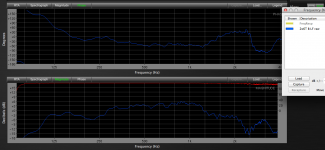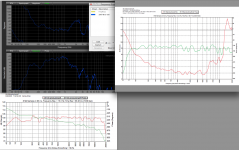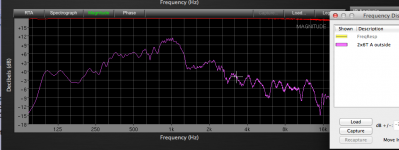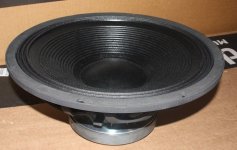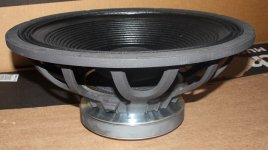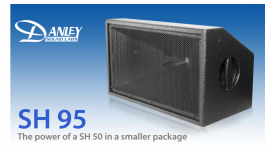How is comparing a LA6-CBMR which would only be used for about two octaves (500-2000 Hz) to a Alpha-6A which can be used for over four octaves (100-2000 Hz) "apples to apples"?You guys need to quit focusing so much on Qts and Qes. Once you seal the rear of any driver, the Q will go up anyway. Tom Danley uses the figure of (Bl^2)/Re as a figure of motor strength merit. A good expample that is apples to apples would be comparing the Eminence Alpha-6A and the LA6-CBMR.
Alpha-6A | Eminence Speaker
LA6-CBMR | Eminence Speaker
The Qts for the Alpha-6A is 0.54
The Qts for the LA6-CBMR is 0.89
However, the LA-CBMR has more than twice the motor strength of the Alpha-6A. In addition, anyone that has heard or used these two drivers will tell you the LA-CBMR is a beast and the Alpha-6A is more of a kitten. Lastly, if you model it and it works, who really cares what is written on the spec sheet?
I'm using a pair of Alpha-6A on a small conical horn/BR from 100-3500 Hz, they do around 125 dB at one meter. Never heard a kitten that loud
Using the LA6-CBMR would provide more midrange output (who needs more than 125 dB for home use?), but require another pair of cones between them and the subs.
Art
Attachments
How is comparing a LA6-CBMR which would only be used for about two octaves (500-2000 Hz) to a Alpha-6A which can be used for over four octaves (100-2000 Hz) "apples to apples"?
Art
Because they are being discussed in the context of a Synergy horn midrange, therefore the Alpha-6A would receive a sealed rear chamber and this would result in a much higher Q. My point is you can't look at a single parameter and determine if a driver is suitable for a Synergy horn. Additionally, you can’t compare the Q of a sealed back mid with a non-sealed unit. Once the back chamber goes on, it all changes.
You guys need to quit focusing so much on Qts and Qes. Once you seal the rear of any driver, the Q will go up anyway.
it goes up, but for a different reason than a weak magnet system
btw, does the back chamber have to be small to 'allign' with front pressure ?
or could the sealed back be much bigger
Why limit the bandwidth of the midrange with a small sealed rear chamber and go four- way when three way will suffice using the Alpha-6A?Because they are being discussed in the context of a Synergy horn midrange, therefore the Alpha-6A would receive a sealed rear chamber and this would result in a much higher Q.
Last edited:
... three way will suffice using the Alpha-6A?
do you mean 'ordinary' 3way horn system, or synergy/unity
Originally Posted by weltersys
... three way will suffice using the Alpha-6A.
Although the frequency response curve in post 1165 is of a pair of Alpha 6 on an "ordinary" conical horn, the offset arrangement would be quite similar, though would have a lower frequency, steeper high frequency cut off.
I would have done a Synergy style horn with the Alpha 6A, but the Eminence APT drivers I happened to have when I built the cabinets aren't happy below 3500 Hz, and the Synergy type offset bandpass arrangement would drop the upper response around an octave, too low for the tiny APT diaphragm.
The Alpha-6A in a Synergy will cover from 100 Hz to around 1200 Hz, where most any typical 1" exit, 1.5"-1.75" diameter diaphragm driver will be capable of "keeping up" to a pair of 6", which horn loaded can do around 125 dB at one meter.
I don't understand why people are complicating the design going four way for home use, unless they actually want 132 dB of midrange output.
Art
... three way will suffice using the Alpha-6A.
It will work in either.do you mean 'ordinary' 3way horn system, or synergy/unity
Although the frequency response curve in post 1165 is of a pair of Alpha 6 on an "ordinary" conical horn, the offset arrangement would be quite similar, though would have a lower frequency, steeper high frequency cut off.
I would have done a Synergy style horn with the Alpha 6A, but the Eminence APT drivers I happened to have when I built the cabinets aren't happy below 3500 Hz, and the Synergy type offset bandpass arrangement would drop the upper response around an octave, too low for the tiny APT diaphragm.
The Alpha-6A in a Synergy will cover from 100 Hz to around 1200 Hz, where most any typical 1" exit, 1.5"-1.75" diameter diaphragm driver will be capable of "keeping up" to a pair of 6", which horn loaded can do around 125 dB at one meter.
I don't understand why people are complicating the design going four way for home use, unless they actually want 132 dB of midrange output.
Art
Last edited:
Originally Posted by weltersys
... three way will suffice using the Alpha-6A.
It will work in either.
Although the frequency response curve in post 1165 is of a pair of Alpha 6 on an "ordinary" conical horn, the offset arrangement would be quite similar, though would have a lower frequency, steeper high frequency cut off.
I would have done a Synergy style horn with the Alpha 6A, but the Eminence APT drivers I happened to have when I built the cabinets aren't happy below 3500 Hz, and the Synergy type offset bandpass arrangement would drop the upper response around an octave, too low for the tiny APT diaphragm.
The Alpha-6A in a Synergy will cover from 100 Hz to around 1200 Hz, where most any typical 1" exit, 1.5"-1.75" diameter diaphragm driver will be capable of "keeping up" to a pair of 6", which horn loaded can do around 125 dB at one meter.
I don't understand why people are complicating the design going four way for home use, unless they actually want 132 dB of midrange output.
Art
I am too busy with work right now to do the sims and find out if I am right.
But my 'hunch' is this:
If you compared the phase response of two Synergy horns, one that uses a closed back midrange, and one that doesn't, I think you'll find that the phase response of the former is going to work better.
The reason is because of the delay that occurs at resonance.
For instance, an Alpha6 with a closed back is going to have a resonance at 460hz.
An Alpha6a is going to have a resonance at 118hz.
Each driver has a delay due to the resonance, but the delay of the Alpha6cbmr is right in the middle of the passband. So we have three things creating a delay:
1) at the high end of the response, there is a delay that's caused by the crossover and the rolloff
2) ditto at the low end
3) there is a delay that occurs in the passband, due to the resonance of the air in FRONT of the driver
Combine those three delays, and you basically have the midbass sound emanating from the throat, but DELAYED as if it was emanating from behind the enclosure itself.
If I am correct, it explains a few things:
1) it explains why VTC uses DSP delay. VTC has to use DSP delay becase they're using a vented alignment for the midbass
2) it explains why Danley uses a sealed back for the BMS coaxials in his synergy horn
There MAY be a 'real' Danley Synergy horn that uses a vented midbass. But I can't think of one offhand. I know that VTC and Yorkville sell some synergy horns with vented midbasses, but I believe they all use DSP delay.
Someone could find out for sure by simming two conical horns, one using the Alpha 6a, and one using the CBMR, then comparing the phase response.
Originally Posted by weltersys
The Alpha-6A in a Synergy will cover from 100 Hz to around 1200 Hz......
Art
actually that is what I hoped to do
but would be ok with 500-1200hz
is it possible to get more detailed info ?
If you compared the phase response of two Synergy horns, one that uses a closed back midrange, and one that doesn't, I think you'll find that the phase response of the former is going to work better.
I haven't heard anyone suggest not to have closed/sealed back
but with a 2way system instead of 3way there would be plenty of space for a bigger back chamber
I haven't heard anyone suggest not to have closed/sealed back
but with a 2way system instead of 3way there would be plenty of space for a bigger back chamber
simulate it and look at the phase response
I'm not 100% sure, but I believe that will be the problem
If you have DSP delay, or you simply don't care if it's phase coherent, then have at it.
But then it's not a Synergy Horn
(You guys might have noticed that I usually talk about Unity horns, not Synergy horns, and that's one of the reasons. As I see it the improved phase response of the Synergy horn is one of the differences between a Synergy and a Unity, and if the phase ain't right, it ain't a Synergy horn.)
An Alpha6a is going to have a resonance at 118hz.
200hz with 3liter sealed
I am too busy with work right now to do the sims and find out if I am right.
But my 'hunch' is this:
A)If you compared the phase response of two Synergy horns, one that uses a closed back midrange, and one that doesn't, I think you'll find that the phase response of the former is going to work better.
1) it explains why VTC uses DSP delay. VTC has to use DSP delay becase they're using a vented alignment for the midbass
2) it explains why Danley uses a sealed back for the BMS coaxials in his synergy horn
There MAY be a 'real' Danley Synergy horn that uses a vented midbass. But I can't think of one offhand. I know that VTC and Yorkville sell some synergy horns with vented midbasses, but I believe they all use DSP delay.
Someone could find out for sure by simming two conical horns, one using the Alpha 6a, and one using the CBMR, then comparing the phase response.
The VTC EL210 is a sealed, not a vented alignment.
The raw phase response of my little 2x6 conical horn/vented alignment deviates about 60 degrees between 200-2kHz, while the "real" DSL SH-100, a vented 2 -way coax deviates about 80 degrees, and the sealed back midrange SH-50 drops about 180 degrees.
All the cabinets exhibit similar phase lag around Fb, where the port output is 180 degrees lagging. By an octave above Fb, the phase response is not much affected by the port.
At any rate "someone" could do the simming you suggest, but the actual measured response has already been done, and they prove your "hunch" is off
Art
Attachments
Ok with a little more than an octave of response, planning an 8 way systemactually that is what I hoped to do
but would be ok with 500-1200hz
is it possible to get more detailed info ?
In posts # 14 and #23 of this thread:
http://www.diyaudio.com/forums/multi-way/240429-help-first-pa-system-build-3.html
there are more details of the 2x6T cabinet.
With some EQ it is a really good sounding cabinet, but it is not flat enough for "hi fi" home use without.
Attachments
Last edited:
Why limit the bandwidth of the midrange with a small sealed rear chamber and go four- way when three way will suffice using the Alpha-6A?
Because that is the context in which I was discussing it. I never said anything about a 4-way. There is no need for a 4-way using the LA6-CBMR, or even the Visaton M10. You know very well most of the Synergy horns are 3-way systems (SH50, SH60, SH46, etc.) The discussion was intended for the nominal crossover points for a 3-way Synergy horn. Crossover points being approximately 1100Hz and 300Hz as per Tom Danley. Now that we've been off on a tangent, getting back to my original point. A single parameter (Qts or Qes) cannot determine if a driver is suitable for midrange use in a Synergy horn.
Because that is the context in which I was discussing it. I never said anything about a 4-way.
ahh, John ... I think you described a 3way synergy with 2x 10" midwoofers
and with subs, it is a 4way system
I was looking for a 2way synergy crossed to 18"woofer, a 3way system
but since you said a 6" would be almost impossible ...
could argue whether the synergy makes sense
but there is another thread for that
btw, I have a woofer
Attachments
ahh, John ... I think you described a 3way synergy with 2x 10" midwoofers
and with subs, it is a 4way system
I was looking for a 2way synergy crossed to 18"woofer, a 3way system
but since you said a 6" would be almost impossible ...
could argue whether the synergy makes sense
but there is another thread for that
btw, I have a woofer
The 6" example was strictly for comparison purposes and to make a point not to select drivers based on Qts or Qes alone. I have no intentions of using a 6". I also never made any mention of subs or anything else.
Last edited:
I also never made any mention of subs ....
sorry, no ... that you didn't
but are the two 10" in the Synergy going to produce all the lows in your system
What I'm looking at the moment is a 3-way Synergy .......
B&C Speakers DE120
Visaton M10
Eminence Delta-10B
I'll use 4 of the Visaton M10s and 2 of the Eminence Delta-10Bs.
Qts go up when sealing becasue of closed air maken cone have more resistance, but it is not the case i mean, I do mean a speaker open and the qts who is result of cone weight and magnet size and afcourse the gap for the vocie coil, it is the tightnes of that together.
I do amps, a lot oef people has about slew rate, a very fast amp don,t sound well, you need not a terrible fast amp, you need control, and bandwith, a speaker afcourse has a lot of limitations, but the motor, coil and cone is like a amp with high damping, control is al about.
When use a mid speaker who has QTS of 0,27 in open air can easely go high up when closing the back with a small enclosure, but still then it has a strong motor who is needed for a horn, I have listen to a open baffle who use speakers with weak motor, I do not like them, when use in a closed box problem is FS go up to high when use low qts and so on, there is not a simple solution for it, it wil be compromise al the time but it is very nice hobby.
As you see this qts thing do tickle people to talk also about things we do not speak off, nice.
regards
kees
I do amps, a lot oef people has about slew rate, a very fast amp don,t sound well, you need not a terrible fast amp, you need control, and bandwith, a speaker afcourse has a lot of limitations, but the motor, coil and cone is like a amp with high damping, control is al about.
When use a mid speaker who has QTS of 0,27 in open air can easely go high up when closing the back with a small enclosure, but still then it has a strong motor who is needed for a horn, I have listen to a open baffle who use speakers with weak motor, I do not like them, when use in a closed box problem is FS go up to high when use low qts and so on, there is not a simple solution for it, it wil be compromise al the time but it is very nice hobby.
As you see this qts thing do tickle people to talk also about things we do not speak off, nice.
regards
kees
kees ... we do know about Qts
small mid drivers have high Qts
Patric like to use 2" for his car fi designs
John wants a 4" for use with small tube amps
its only me wanting bigger mid for bass guitar setup
what are your plans regarding the Synergy ? ... just curious
maybe you should go back and read some of Patrick's and John's posts where they explain very detailed what we are facing here ... its not simple
they do not need us to do what they want, its the other way round
small mid drivers have high Qts
Patric like to use 2" for his car fi designs
John wants a 4" for use with small tube amps
its only me wanting bigger mid for bass guitar setup

what are your plans regarding the Synergy ? ... just curious
maybe you should go back and read some of Patrick's and John's posts where they explain very detailed what we are facing here ... its not simple
they do not need us to do what they want, its the other way round
A Synergy with a pair of Alpha 6A (or 8A) and HF driver would allow a crossover point of around 100 Hz to the 18" woofer, which means the woofer placement is not very critical, as it would be if you were using it up to 500 Hz.I was looking for a 2way synergy crossed to 18"woofer, a 3way system
but since you said a 6" would be almost impossible ...
btw, I have a woofer
If you want to spend more money there are better B&C cones.
For bass use making the 2 way Synergy wedge shape like the DSL SH-90 (which uses 2 x8" and a 1") would be a good move.
You could do removeable BR port covers for use with or without the sub.
Attachments
Last edited:
- Home
- Loudspeakers
- Multi-Way
- Suitable midrange cone, for bandpass mid in Unity horn.
